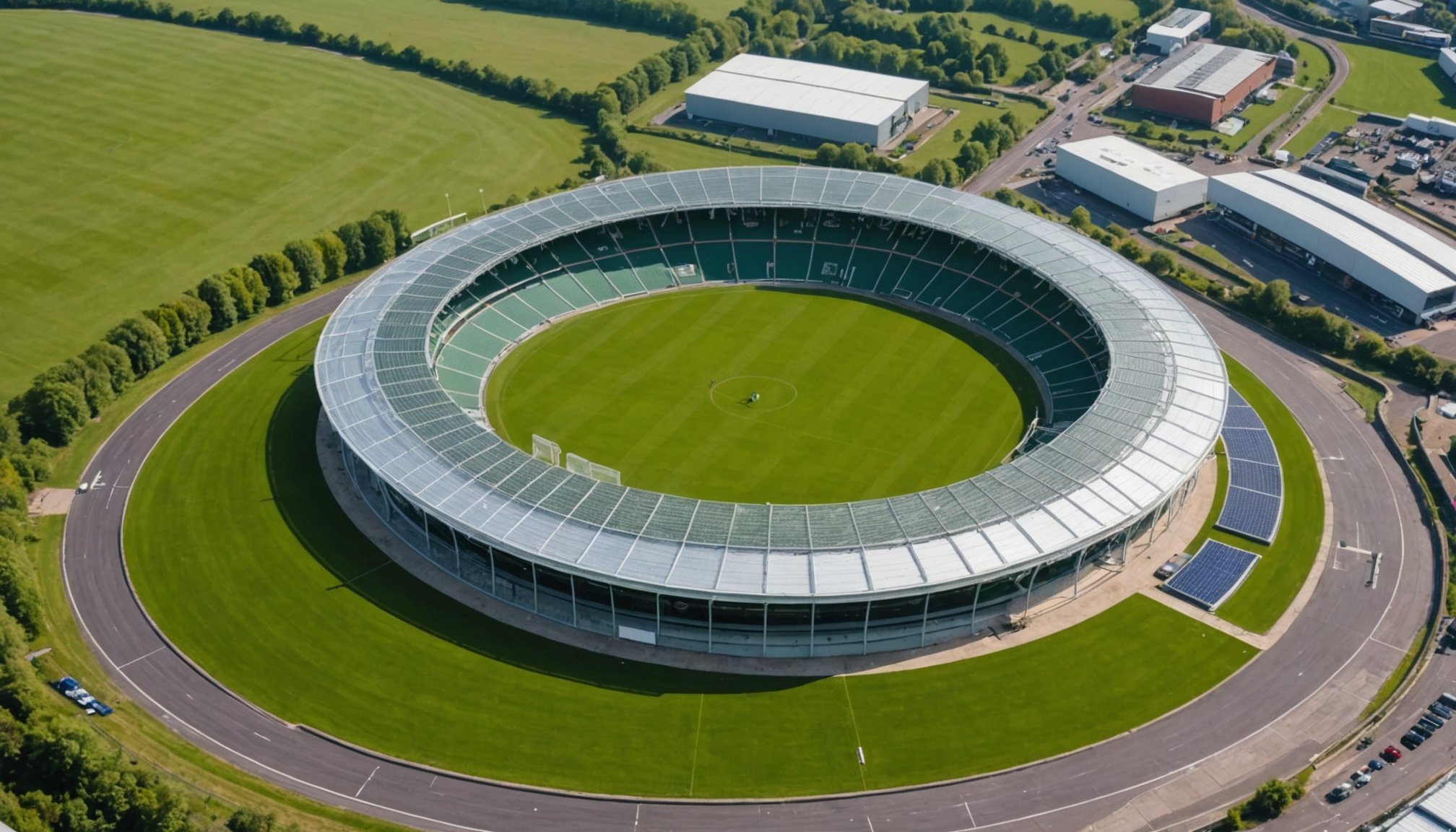Overview of Environmental Impact in Sports Facilities
Sports facilities in the UK are grappling with significant environmental impact challenges. One pressing issue is the substantial carbon footprint generated, from large energy consumptions to extensive waste production. These challenges are magnified by events demanding high operational levels, impacting resources and contributing to pollution.
The importance of reducing this footprint is increasingly recognized within the sector. Embracing sustainability does not only align with environmental conservation goals but also provides practical benefits, like cost savings and reputation enhancement. Implementing energy-efficient systems, reducing water usage, and comprehensive waste management are pivotal steps sports facilities can undertake to mitigate their impact.
This might interest you : Eco-friendly game days: innovative approaches for uk sports venues to achieve sustainability and maintain performance
Governance plays an integral role in driving sustainability efforts. The UK implements stringent regulations to guide facilities in adopting environmentally friendly practices. These include regulations on energy usage, waste management protocols, and carbon reduction targets. Adhering to these regulations is crucial not only for compliance but also for promoting long-term sustainability in the sporting sector. Through collaborative efforts and responsible practices, sports facilities can contribute significantly towards sustainable futures, proving that athletic feats should not come at the expense of the planet.
Renewable Energy Solutions
Integrating renewable energy sources, such as solar panels and wind energy, into existing infrastructure presents numerous benefits. Installing solar panels in sports facilities, for instance, can significantly reduce energy costs while promoting environmental sustainability. Solar panels harness the power of the sun, an abundant source of clean energy, decreasing reliance on fossil fuels. Additionally, they can provide a constant power supply by storing energy in batteries for use when solar output is low.
Additional reading : Maximizing athlete performance: harnessing data analytics for superior results in uk sports teams
Successful implementations of wind energy provide insightful case studies. Many establishments have embraced wind turbines to generate electricity, showcasing their feasibility and efficiency. Wind energy is particularly advantageous in areas with consistent wind patterns, further increasing energy reliability and minimizing the environmental footprint.
Strategies for integrating these renewable sources into existing infrastructures are crucial. They often involve assessing the current energy needs, evaluating site-specific conditions, and designing systems tailored to those criteria. Encouraging collaboration among stakeholders ensures that renewable installations are both practical and economically viable. Employing a combination of renewable sources, such as solar panels alongside wind energy, can create a more balanced and resilient energy system. These insightful approaches showcase the growing viability of renewable solutions.
Water Conservation Techniques
Incorporating effective water conservation techniques is crucial for reducing operational costs and ensuring sustainable usage. By implementing strategies such as rainwater harvesting, businesses and households can capture and utilise rain to decrease dependency on municipal water supplies, thereby cutting down on water bills and conserving resources.
Technologies for Rainwater Harvesting
Modern technologies have transformed rainwater harvesting into a highly efficient practice. Systems are now equipped with advanced filtering and storage solutions, enabling users to collect large volumes of water with minimal contamination. This harvested water can be used for non-potable purposes such as irrigation, landscaping, and flushing toilets, significantly alleviating the pressure on fresh water reserves.
Low-flow Fixtures for Increased Efficiency
The adoption of low-flow fixtures is another pivotal element in water conservation efforts. Devices like low-flow faucets, showerheads, and toilets are engineered to use considerably less water while maintaining functionality and user comfort. Installing these fixtures not only reduces water usage but also decreases the energy required for heating water, leading to further savings. By integrating these technologies, it’s possible to achieve a more efficient and environmentally-friendly water management system, addressing both economic and ecological benefits.
Sustainable Materials and Construction
The use of sustainable materials is crucial in modern facility construction, especially within the context of eco-friendly construction and green building. These materials reduce environmental impact and promote resource efficiency. Materials like recycled steel, bamboo, and reclaimed wood not only reduce carbon footprints but also offer durability and aesthetic appeal.
In the UK, the green building certification process is a guiding framework for sustainable construction practices. Certifications such as BREEAM (Building Research Establishment Environmental Assessment Method) assess the sustainability of buildings based on criteria like energy usage, material sourcing, and water efficiency. These certifications encourage developers to incorporate eco-friendly solutions and achieve higher standards of sustainability.
A prime example of successful eco-friendly construction projects in sports is the Olympic Velodrome in London. This venue utilized materials such as sustainably sourced timber and energy-efficient systems, setting a benchmark for green sports facilities. Such projects highlight the potential of sustainable materials in creating environmentally conscious architectures that serve both aesthetic and functional purposes.
By choosing green building practices, developers can contribute to a sustainable future, significantly mitigating the environmental impacts of construction while providing efficient, durable, and inspiring spaces.
Waste Management Strategies
Implementing robust waste management strategies in sports facilities not only aids environmental preservation but also contributes to operational efficiency. A pivotal aspect lies in developing effective recycling programs. These programs facilitate the collection and sorting of various waste materials like plastics, metals, and paper, significantly reducing landfill contributions. Successful recycling initiatives often integrate clear signage and dedicated bins placed strategically across the facility to encourage participation.
Composting is another vital component of waste management, particularly for organic waste generated from catering services. By turning food scraps into nutrient-rich soil, facilities can reduce waste and even contribute to local gardening projects. Composting not only minimizes the volume of waste sent to landfills but also promotes a closed-loop system in sustainable practices.
Education plays a crucial role in these strategies. Educating staff and users on proper waste disposal methods fosters a culture of responsibility. Workshops, informational posters, or digital displays can be used as tools to engage and inform individuals about the benefits of recycling and composting. Awareness leads to active participation in these programs, ensuring their long-term success and, ultimately, a greener footprint for the facility.
Transportation and Accessibility
Supporting sustainable transport initiatives around sports facilities is crucial for both visitors and the environment. A significant step is the promotion of public transportation options for attendees. Easy access to buses, trains, or trams encourages visitors to choose eco-friendly travel methods, reducing carbon footprints. Making schedules readily available and integrating digital ticketing options can significantly enhance convenience.
An equally important component is developing a cycling infrastructure. Providing safe, dedicated bike lanes around facilities encourages more individuals to choose cycling, a healthy and environmentally friendly commute method. Additionally, installing secure bike storage solutions reassures cyclists about the safety of their equipment while attending events.
For staff and patrons with vehicles, incentivising the usage of electric vehicles (EVs) integrates seamlessly with green initiatives. Offering perks such as reserved premium parking spots or discounted charging stations can motivate this transition towards sustainability. In fact, some venues set examples by using EVs within their operational fleet, showcasing their commitment to environmental responsibility.
Each of these strategies not only promotes better transport practices but also creates a positive engagement with visitors, staff, and the surrounding community, bolstering a shared commitment to a sustainable future.
Community Engagement and Education
Incorporating community engagement is pivotal to advancing sustainability through sports facilities. These spaces can act as hubs for promoting sustainable practices, fostering awareness, and instilling green values within the local community. An integrated approach involving educational programs is essential. By hosting educational programs, sports facilities can enlighten individuals on eco-friendly practices, encouraging behaviour changes that benefit both the community and the environment.
Sustainability workshops are especially effective in nurturing an eco-conscious mindset. They provide practical knowledge and tools that empower participants to implement sustainable actions in their daily lives. Examples of successful programs often include themes like waste reduction, energy conservation, and water management, making complex topics accessible and engaging.
Local communities play a crucial role in the success of sustainability initiatives. A few strategies to involve them effectively include interactive events, volunteer opportunities, and partnerships with local organisations to co-create projects. Engaging residents not only bolsters efforts but also cultivates a sense of ownership and pride in their environment. This cooperation creates a robust foundation for long-lasting sustainability initiatives, ensuring the sports facilities serve as more than just physical spaces, but as catalysts for meaningful change.
Measuring and Reporting Progress
Understanding the significance of setting measurable sustainability goals is crucial for effectively monitoring progress. Establishing clear objectives enables UK sports facilities to apply sustainability metrics and tracking tools effectively, thereby enhancing their environmental accountability.
Utilising various tools and methodologies facilitates accurate monitoring of progress. Implementing practices such as carbon footprint analysis and energy consumption assessments provides tangible data. These metrics help identify areas needing improvement while celebrating achievements. Moreover, these practices support the formulation of strategic plans, aiding facilities in aligning their operations with sustainability benchmarks.
Effective reporting practices not only showcase the efforts of UK sports facilities but also build trust with stakeholders. Regular reports, employing visual formats like graphs and dashboards, ensure transparency and highlight any adjustments needed to stay on track.
Case studies illustrate the progress of UK sports facilities in embracing sustainability. For example, a notable facility reduced its carbon emissions by 30% within five years through meticulous tracking and adjustment of energy use. These successes exemplify how adopting robust measurement and reporting practices can lead to significant environmental advancements in the sector.
Encouraging the adoption of these strategies promises a sustainable future for the sports industry.
Challenges and Solutions
Navigating the path toward sustainability presents several challenges for sports facilities. A primary barrier is the initial cost of implementing eco-friendly technologies, which can be prohibitively high. Many facilities also encounter resistance to change, both internally and externally, due to entrenched habits and operational routines.
To overcome these sustainability challenges, facilities can adopt best practices that blend financial prudence with environmental responsibility. For instance, partnering with energy companies to conduct audits can identify areas for improvement without significant upfront costs. Additionally, fostering a culture of sustainability among staff and stakeholders ensures long-lasting commitment.
The journey towards sustainability is also supported by various resources and organisations available to UK sports facilities. Several governmental and independent bodies offer grants, technical support, and networking opportunities. These include partnerships with environmental think tanks and use of sustainability certification schemes to drive accountability.
Moreover, sharing success stories of facilities that have effectively tackled these barriers serves as a motivational tool for others. By highlighting best practices and collaboratively overcoming common barriers, the sports sector can achieve sustainability goals while setting an example for other industries. This not only ensures environmental benefits but also secures a healthier future for community sports.











